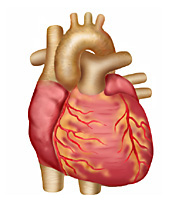heart draw and topic

But the heart muscle is special because of what it does. The heart sends blood around your body. The blood provides your body with the oxygen and nutrients it needs. It also carries away waste.
How the Heart Beats
How does the heart beat? Before each beat, your heart fills with blood. Then its muscle contracts to squirt the blood along. When the heart contracts, it squeezes — try squeezing your hand into a fist. That's sort of like what your heart does so it can squirt out the blood. Your heart does this all day and all night, all the time. The heart is one hard worker!
Parts of the Heart
Well, your blood relies on four special valves inside the heart. A valve lets something in and keeps it there by closing — think of walking through a door. The door shuts behind you and keeps you from going backward.
Two of the heart valves are the mitral (say: MY-trul) valve and the tricuspid (say: try-KUS-pid) valve. They let blood flow from the atria to the ventricles. The other two are called the aortic (say: ay-OR-tik) valve and pulmonary (say: PUL-muh-ner-ee) valve, and they're in charge of controlling the flow as the blood leaves the heart. These valves all work to keep the blood flowing forward. They open up to let the blood move ahead, then they close quickly to keep the blood from flowing backward.
How Blood Circulates
You probably guessed that the blood just doesn't slosh around your body once it leaves the heart. It moves through many tubes called arteries and veins, which together are called blood vessels. These blood vessels are attached to the heart. The blood vessels that carry blood away from the heart are called arteries. The ones that carry blood back to the heart are called veins.
The movement of the blood through the heart and around the body is called circulation (say: sur-kyoo-LAY-shun), and your heart is really good at it — it takes less than 60 seconds to pump blood to every cell in your body.
Your body needs this steady supply of blood to keep it working right. Blood delivers oxygen to all the body's cells. To stay alive, a person needs healthy, living cells. Without oxygen, these cells would die. If that oxygen-rich blood doesn't circulate as it should, a person could die.
The left side of your heart sends that oxygen-rich blood out to the body. The body takes the oxygen out of the blood and uses it in your body's cells. When the cells use the oxygen, they make carbon dioxide and other stuff that gets carried away by the blood. It's like the blood delivers lunch to the cells and then has to pick up the trash!
When you go for a checkup, your doctor uses a stethoscope to listen carefully to your heart. A healthy heart makes a lub-dub sound with each beat. This sound comes from the valves shutting on the blood inside the heart.
The first sound (the lub) happens when the mitral and tricuspid valves close. The next sound (the dub) happens when the aortic and pulmonary valves close after the blood has been squeezed out of the heart. Next time you go to the doctor, ask if you can listen to the lub-dub,
Even though your heart is inside you, there is a cool way to know it's working from the outside. It's your pulse. You can find your pulse by lightly pressing on the skin anywhere there's a large artery running just beneath your skin. Two good places to find it are on the side of your neck and the inside of your wrist, just below the thumb.
You'll know that you've found your pulse when you can feel a small beat under your skin. Each beat is caused by the contraction (squeezing) of your heart. If you want to find out what your heart rate is, use a watch with a second hand and count how many beats you feel in 1 minute. When you are resting, you will probably feel between 70 and 100 beats per minute.
When you run around a lot, your body needs a lot more oxygen-filled blood. Your heart pumps faster to supply the oxygen-filled blood that your body needs. You may even feel your heart pounding in your chest. Try running in place or jumping rope for a few minutes and taking your pulse again
heart, organ that serves as a pump to circulate the blood. It may be a straight tube, as in spiders and annelid worms, or a somewhat more elaborate structure with one or more receiving chambers (atria) and a main pumping chamber (ventricle), as in mollusks. In fishes the heart is a folded tube, with three or four enlarged areas that correspond to the chambers in the mammalian heart. In animals with lungs—amphibians, reptiles, birds, and mammals—the heart shows various stages of evolution from a single to a double pump that circulates blood (1) to the lungs and (2) to the body as a whole.
In humans and other mammals and in birds, the heart is a four-chambered double pump that is the centre of the circulatory system. In humans it is situated between the two lungs and slightly to the left of centre, behind the breastbone; it rests on the diaphragm, the muscular partition between the chest and the abdominal cavity.

Comments
Post a Comment